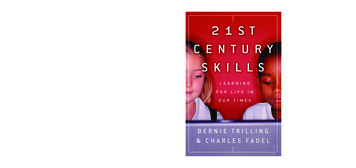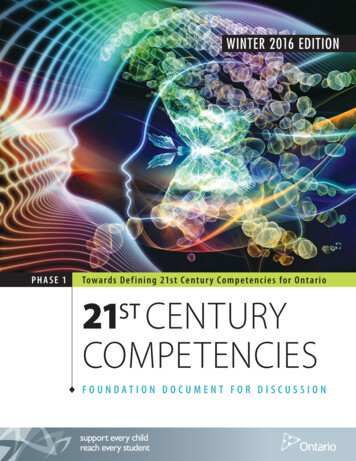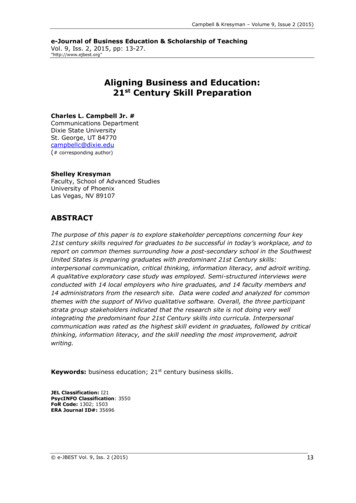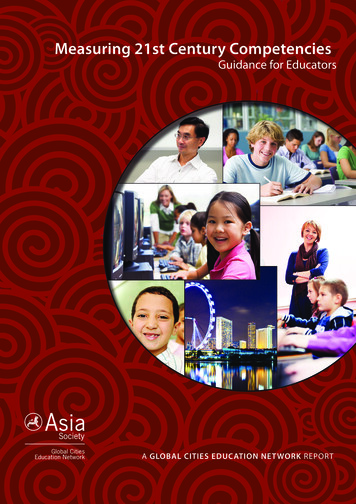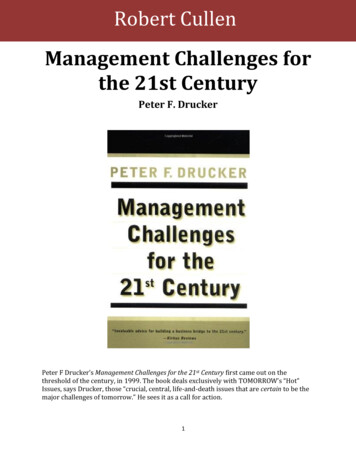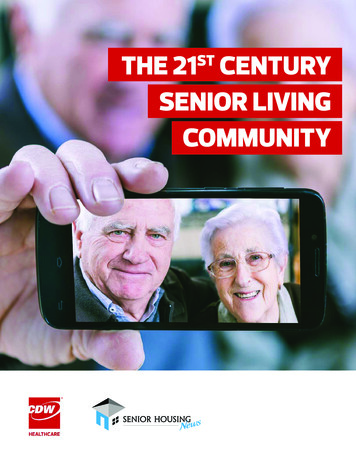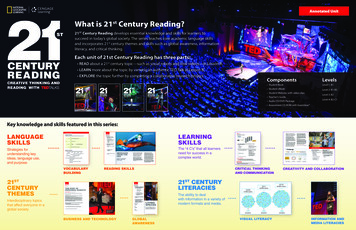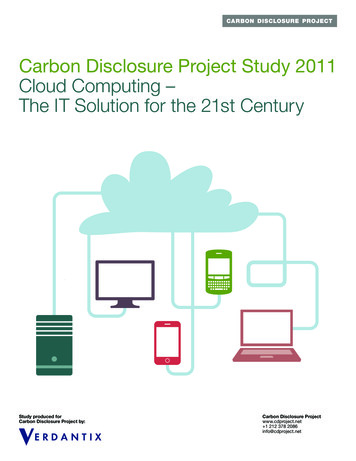
Transcription
OPEN ACCESSEURASIA Journal of Mathematics Science and Technology EducationISSN 1305-8223 (online) 1305-8215 (print)2017 13(2):487-501DOI 10.12973/eurasia.2017.00627aEnhancing 21st Century Skills with AR:Using the Gradual Immersion Method to developCollaborative CreativityJorge C SanabriaUniversidad de Guadalajara, MEXICOJesús Arámburo-LizárragaUniversidad de Guadalajara, MEXICOReceived 19 March 2016 Revised 16 July 2016 Accepted 22 August 2016ABSTRACTAs 21st century skills (e.g., creativity and collaboration) are informally developed by techsavvy learners in the Digital Age, technology-based strategies to develop such skills in nonformal and formal contexts are necessary to reduce the gap between academic andbusiness organizations on the one hand, and the revolutionary wave of self-taughtnetworked learners on the other. In light of this, the Gradual Immersion Method (GIM) wasdesigned to enhance collaborative creativity using interactive devices and augmentedreality (AR), to support creativity-based learning, such as in the integrated study of Science,Technology, Engineering, Arts and Mathematics (STEAM). The GIM consists of threeintuitive modules wherein learners collaboratively achieve learning object goals throughinteraction with images and 3D models, in a sequential transition from 2D to 3D and thento AR. In this paper, the process is illustrated through the deployment of the GIM in thestudy of Surrealist art features, using the Art Movement Learning App (AMLA), an areaspecific technological solution based on the GIM, designed as foundation architecture forthe investigation of a wide range of topics in an interactive manner.Keywords: 21st Century Skills, AMLA, AR, Creativity, GIM, STEAMINTRODUCTIONThe increasing call for a culture of innovation, driven by technological shifts in industry,necessitates the development of 21st century skills which promote creative thinking andteamwork in educational and business settings, and facilitate the creation of new knowledge(Pacific Policy Research Center, 2010). Creativity and collaboration, both developable skills ofgreat value in the pursuit of these goals, are typically observed in arts education, where thedesign process and creative process are commonly employed in what industry terms design Authors. Terms and conditions of Creative Commons Attribution 4.0 International (CC BY 4.0) apply.Correspondence: Jorge C. Sanabria, Sistema de Universidad Virtual, Universidad de Guadalajara. Av. La Paz #2453,Col. Arcos Sur, C.P. 44130, Guadalajara, Jal. México.sanabria@suv.udg.mx
J. C. Sanabria & J. Arámuburo-LizárragaState of the literature The new culture of innovation demands the development of 21st century skills which promotecreative thinking and teamwork in educational and business settings.Technological tools such as Augmented Reality (AR) are making it easier for users toautonomously produce flexible learning and/or entertainment-based software and hardwarewhich reflect the dynamism of their personality.There is ever-increasing demand for technology-based methods to support learning and guideusers to filter and acquire relevant knowledge according to the present and future academic andbusiness demands.Contribution of this paper to the literature This paper investigates the features and potentialities of the Gradual Immersion Method (GIM)as a strategic cognitive-pedagogical approach that promotes intuitive learning through digitalcreation, using interactive devices and 2D, 3D and AR activities.A GIM-based application called the Art Movement Learning App (AMLA) was developed, whichfacilitates intuitive collaborative performance of tasks using interactive devices and AR.The GIM enhances creativity, collaboration, and other relevant 21st century skills that aidperformance in formal academic, as well as in non-formal environments.thinking; that is, solving problems to achieve a given outcome (e.g., software, products,advertisements). However, these features of design are also increasingly being consideredrelevant for interdisciplinary work which demands problem solving and the search foralternative solutions in a broadly aesthetic context, as clearly represented in STEAM (Science,Technology, Engineering, Arts and Mathematics) studies, a far-reaching academic proposalwhich embraces methods typical of the creative arts, in order to enhance science education(Bequette & Bequette, 2012).At the same time, there is ever-increasing demand for technology-based methods tosupport learning. With the technological empowerment of new generations of learners usingApps in mobile interactive devices, and the development of augmented reality (AR) systemsthat combine real and digital worlds, the gap between traditional teaching methods in formalacademic institutions and alternative autonomous learning has grown, accelerated by therapid development of new applications, many designed by users themselves. On the otherhand, these same conditions are highly conducive to informal and non-formal learning,acquired through experience outside the traditional academic settings, such as family, interestbased communities, or the workplace, contributing to skills development which can beidentified, and can give rise or contribute to qualifications through accreditation or validationprocesses (UNESCO, 2012). However, in attempting to enrich learning experiences that fosterdevelopment of 21st century skills in educational contexts, the threat of information overloadcalls for innovative technology-based methods and strategies which guide users to filter andacquire relevant knowledge according to the present and future academic and businessdemands.488
EURASIA J Math Sci and Tech EdAgainst this background, we here describe the salient features and potentialities of theGradual Immersion Method (GIM), a strategic cognitive-pedagogical approach that promotesintuitive learning through digital creation, using interactive devices and 2D, 3D and ARactivities. The GIM enhances creativity, collaboration, and other relevant 21st century skillsthat aid performance in non-formal environments such as are found in museums, communityentrepreneurial groups and other organizations, as well as in formal academic contexts suchas STEAM.The structure of the article is as follows. Section 1 provides an analysis of the role ofcreative skills and AR technology in relation to 21st century educational demands. Section 2introduces the research methodology, and then details both the GIM and the Art MovementLearning App (AMLA), a software architecture specially designed for a GIM-based case studyinvolving the pedagogical introduction to Surrealism and other art movements. Section 3summarizes the case study, and Section 4 presents the main conclusions of the article.21st century skills in educationBased on the current demands of the information- and knowledge-based global societyof the Digital Age, the practices and expectations of educational and working environmentshave been analyzed by educators and policy makers to identify and define the 21st centuryskills which are required for citizens to thrive in this era of rapid transformation. Though stillin the process of being fully articulated, several frameworks for such 21st century skills havebeen released and are in ongoing revision.Two well-known studies investigate the specific roles of creativity and collaboration(among other skills) in present and future education. A comprehensive study by NCREL andthe Metiri Group (2003), focusing on sources such as literature reviews, industry reports,workforce trends, and data from educators, identified four clusters of skill sets, constitutingthe so called enGauge 21st Century Skills: digital-age literacy, inventive thinking, effectivecommunication, and high productivity. The inventive-thinking cluster, characterized byhigher-level cognitive skills critical to thriving in the Digital Age, includes the concept ofcreativity, which is defined as “The act of bringing something into existence that is genuinelynew and original, whether personally (original only to the individual) or culturally (where thework adds significantly to a domain of culture as recognized by experts)” (NCREL & MetiriGroup, 2003). The concept of collaboration is discussed as part of ‘Teaming and collaboration’in the effective-communication cluster, wherein the study stresses the importance of managingthe usage of information technologies with awareness of their impact on society; the conceptis defined as “Cooperative interaction between two or more individuals working together tosolve problems, create novel products, or learn and master content” (NCREL & Metiri Group,2003).The second study, structured as a collective vision of the skills, knowledge, and expertisenecessary for learners to generally succeed in contemporary work and life, is the ‘Frameworkfor 21st Century Learning’, developed by the Partnership for 21st Century Learning (2007)489
J. C. Sanabria & J. Arámuburo-Lizárragawith various inputs from educational and business sources. The framework is divided into anumber of ‘21st Century Student Outcomes’, including: key subjects and 21st century themes;learning and innovation skills; information, media and technology skills; and life and careerskills. Learning and innovation skills distinguish learners who are ready to face complex lifeand work experiences from those who are not. These skills include: creativity and innovation;critical thinking and problem solving; communication; and collaboration. In addition, theframework identifies a number of ‘21st Century Support Systems’ aimed at making thelearning experience relevant, engaging, and personalized (Partnership for 21st CenturyLearning, 2007).Regarding the connection between education and business in the Digital Age, Ken Kay,founder of the ‘Partnership for 21st Century Learning’, notes that: “A 21st century educationmust be tied to outcomes, in terms of proficiency in core subject knowledge and 21st centuryskills that are expected and highly valued in school, work, and community settings” (Bellanca& Brandt, 2010). In this demanding context, creativity and collaboration stand out for theirgreat importance in the process of active learning, and thus together formed the primary focusfor this study.Creativity in educationCreative skills are considered relevant when applied in a specific context, for example inthe engineering of a machine, the formulation of a chemical model, or the digital creation ofan artwork. From the researcher’s perspective, creativity and education typically overlapwhen relying on insight to solve problems, innovating the teaching-learning process, andseeking to enhance learners’ creativity (Smith & Smith, 2010); all of which are recurring themesin efforts to enhance creativity in STEAM studies (Connor, Karmokar, Whittington, & Walker,2014; Guyotte et al., 2015).From a creative cognition perspective, creativity can be enhanced by quasi-perceptualexperiences based on mental processes such as the generation of visual imagery, which maybe useful in enhancing learners’ creative skills for the invention or engineering of innovativeoutcomes (Finke, Ward, & Smith, 1992). One such process is bisociation, the deliberatecombination of two elements or thoughts (such as objects or words) with no obviousrelationship, which increases the likelihood of generating innovative outcomes (Koestler,1964). Thus, by identifying and properly deploying specific cognitive techniques for enhancingcreativity in education, problems may be solved, innovative products designed, and artisticexpressions produced (Baughman & Mumford, 1995; Wisniewski & Love, 1998). However, ameta-study by Kowaltowski (2009) concerning methods for stimulating creativity, includingmental maps, focus groups, and brainstorming, concluded that, though a variety of suchapproaches are used in the educational contexts of the arts and engineering design forexample, teachers may not know whether the means employed in their courses are methods,techniques, or tools. This suggests that, when proposing such creativity enhancingapproaches, especially if technology-based, it is desirable to properly define the relevant490
EURASIA J Math Sci and Tech Edobjectives, characteristics, and even mental processes involved, as well as to describe therelevant contexts for application.Augmented Reality (AR) in educationIn the 21st century, the role of the learner has undergone a paradigm shift in whichhe/she is conceived as a transformer rather than just a receiver of information. Currenttechnological tools have empowered young users, making it easier for them to autonomouslyproduce flexible learning and/or entertainment-based software and hardware which reflectthe dynamism of their personality. At the same time, the increasing diversity among learners,in the manner of perceiving the world through interactive digital displays, has resulted in aboom in digital education, which has been accompanied by burgeoning growth in electronic,mobile, blended, home, and other forms of learning; all of which demands constant renewalof the skills and approaches of those providing learning experiences in education. Interactingwith digital displays, learners explore compelling, imaginative, and self-paced practicalexperiences which disrupt traditional systematic patterns for generating knowledge and skills.Meanwhile, with its simplicity, portability, and wide application, augmented reality (AR) haspositioned itself as a valuable tool for enhancing traditional curricula and learning techniques.Ideally, AR systems enable the incorporation of 3D digital elements in the real world,providing interaction in real time and enriching the perceived information, with the utopianaim of a fully ‘Mixed Reality’, the seamless integration of the real and digital worlds (Milgram& Kishino, 1994; Azuma, 1997).AR has typically been applied in education as a means to introduce abstract, difficult toassimilate, dangerous, and/or conventionally inaccessible information and experience. Morespecifically, in terms of the development of creative skills, it is proving to be a useful tool, withgreat promise for the future development of learning (Bower, 2014). Typical AR deploymentsrange from collaborative tools for promoting autonomous learning in engineering labs(Martin-Gutierrez, Fabiani, Benesova, Meneses, & Mora, 2015), to enhancing learning inmathematics (Coimbra, Cardoso, & Mateus, 2015), and supporting the study of computerscience using mobile devices (Kose, Koc, & Yucesoy, 2013).AR applications are unquestionably desirable for strengthening the aforementioned 21stcentury skills involved in STEAM studies, for example (Muschio, Zhu, & Foster, 2015), but itis imperative for any such application to be governed by pedagogical methods aimed atsupporting the development of such skills.METHODOLOGYThis is a theoretical study whose aim is to present a method, along with relatedtechnological support, to enhance creativity and collaboration in the learning process. Themethod employs AR technology, with a focus on non-formal learning, and an eye to assistinglearners in STEAM studies and other formal and informal contexts.491
J. C. Sanabria & J. Arámuburo-LizárragaThe Gradual Immersion Method (GIM)In response to the need for guidelines to enhance creativity and collaboration intechnological and educational contexts, Sanabria (2015) proposed the Gradual ImmersionMethod (GIM), a cognitive-pedagogical approach that encourages intuitive learning usingdigital interactive devices and AR. The method is composed of three modules which, as itsname suggests, enable learners’ gradual immersion in two complementary respects:facilitating the interactive appropriation of target knowledge, and guiding their perceptionthrough increasingly complex spatial dimensions, toward Mixed Reality. The development ofcreative skills, together with the acquisition of knowledge on a selected topic, is facilitated bymeans of reusable instructional components known as learning objects (LOs): digitalinformation structures supporting education or training, ideally integrated as a set ofcomputer-based instructions, goals, learning tasks, and assessment instruments (Wiley, 2000).In the GIM, the LOs focus on challenging tasks involving interactive devices, carried outcollaboratively by teams of 4-5 learners, and assessed at the end of a given LO (phase) or setof LOs (module), by the learners themselves, their peers, the researchers, and/or the audience.Examples of GIM-based LOs include combining two images to create a third with unexpectedfeatures, and identifying the common characteristics of a diverse group of images; alwaysencouraging learners to appropriate target knowledge through collaborative interaction.With respect to the progress through spatial dimensions, the GIM guides learnersthrough LOs on digital interactive displays, with activities performed in 2D, 3D, and finallyAR, which gradually immerses them in a Mixed Reality experience. This process takes placeat the interface, where the LOs present different challenges based on the following sequence:interacting with flat images (2D); working with volume on 3D models (3D); and combiningdigital elements (in 2D and 3D) with real-world elements (AR).The essence of the GIM is the creative process which iterates through generative andexploratory cognitive cycles, based on three modules (Figure 1) which guide the learners fromfamiliarization with key features of a given topic, to digital creation using AR, and finally tothe exhibition of products of their learning experience. The three modules are divided intophases with specific goals that together support the objective of the respective module, andenable spatial transition from 2D to 3D, and then to AR.492
EURASIA J Math Sci and Tech EdFigure 1. The three GIM modules (Sanabria, 2015)The first module aims at familiarizing teams of learners with a specific topic, in sixphases (Figure 2). (1) Observation: a series of images are displayed, and a list of commonfeatures (or ‘criteria’) is generated by each team. (2) Combination: provided with a number ofimages (e.g., people, objects, animals), teams create original combinations based on the criteriagenerated in Phase 1; the process is then repeated with 3D models. (3) Association: a primaryimage is displayed, surrounded by its key elements, and teams assign these elements to theiroriginal positions in the image. (4) Grouping: a series of images are categorized based on theircommon characteristics, collaboratively identified by each team. (5) Discernment: pairs ofimages are displayed, and teams choose the one that most accurately corresponds to thecriteria and characteristics defined in the previous phases. (6) Evaluation: combinationscreated in 2D and 3D in Phase 2 are evaluated by other teams; for instance, using an embeddedaffective or creativity scale. Depending on the objective, evaluation may be scheduled forearlier or later in the overall process (i.e., from the first to the fourth degree of intuitionsensitive peer evaluation).Figure 2. Module I: Six phases of the GIM on interactive surfaces (Sanabria, 2015)493
J. C. Sanabria & J. Arámuburo-LizárragaThe second module consists of a single generative phase involving an iterative transitionprocess, dedicated to the digital creation of an AR product based on 3D models (Figure 3).After working through a creative process of visualizing and articulating a combination ofobjects through capturing and combining 3D models, the team generates, regenerates, ormodifies its preventive structures. These structures are externalized through the creation of anAR product which combines a real object (originally captured in the field) and a digital object(originally captured or designed in the lab).Figure 3. Module II: AR generative phase on mobile devices (Sanabria, 2015)The third module completes the GIM process, with the exhibition of an AR product(Figure 4). The act of displaying products (exploratory phase) offers learners a chance tointerpret their own externalized preinventive structures, and at the same time enables anaudience to provide feedback, which can be measured through their affective reactions forexample. If desired, audience members may also be provided with a digital interface wherethey can create their own 3D/AR products, reproducing a synthesized version of the observedexhibition. Meanwhile, for the facilitator or researcher, audience data, in the form of feedback,reaction, and/or the 3D/AR creation process, enables assessment of the learners’ experience,and specifically, how well the respective LOs were incorporated and expressed by each team’sAR product and assimilated by the audience.To illustrate the deployment of the GIM in non-formal learning, a contextualized caseinvolving the study of art movements is presented below. The section also describes thesoftware application which was specifically designed to support the three modules above, aswell as its architectural base, which can be easily adapted to support STEAM studies.494
EURASIA J Math Sci and Tech EdFigure 4. Module III: AR public exhibition on mobile devices (Sanabria, 2015)Software developed for the GIMTo support the learning of art movements (e.g., Surrealism, Cubism, Impressionism),Arámburo-Lizárraga & Sanabria (2015) proposed a GIM-based application called the ArtMovement Learning App (AMLA), which facilitates intuitive collaborative performance oftasks using interactive devices and AR. The AMLA consists of two modules: (1) familiarization(based on the GIM’s Module I), which introduces key features of a chosen art movement, insix phases involving interactive LOs, including inter-participant evaluation; and (2) an ARmodule (based on the GIM’s Modules II and III), which guides learners through the generationof a digital creative product, and then the mounting of this product in a real-worldenvironment, using AR with GPS coordinates, known as AR Level 2 (Lens-Fitzgerald, 2009).In order to provide LOs for interactive whiteboards (IWBs) and mobile devices, aimedat exploring features of different art movements, the Unity3D multiplatform game engine(Unity, 2016) was chosen as an ideal framework for developing the AMLA. The AMLA’sarchitecture is based on four concepts corresponding to Unity3D elements: (1) assets, (2)GameObjects, (3) scenes, and (4) scripts; which were adapted as follows:1) Assets: supporting files to create and configure LOs; for example, artworks (2D images),instructions (text), or animals, objects, and people (3D objects).2) GameObjects: containers that enable the configuration of objects on the screen; forexample, a horizontal reel displaying a set of artworks or interface elements (text, icons,buttons, etc.).3) Scenes: structures containing the GameObjects, to direct their functionality toward agiven objective; for example, each of the six phases of the GIM (observation, combination,etc.) is presented as a scene.495
J. C. Sanabria & J. Arámuburo-Lizárraga4) Scripts: programmed code providing interactivity among Scenes and GameObjects; forexample, transitions between GIM phases, or validating input devices (e.g., keyboard,mouse, touch screen).Just as the AMLA can be easily adapted for teaching art movements, the simplemodification of its assets enables effective STEAM studies benefitting from creative capability,such as exploring chemical bonding, eliciting bisociated (disruptive) industrial design, orimaginative innovation of engineering structures. In terms of the 21st century skillsframeworks, the AMLA aids in the development of technological skills with regard to creating,evaluating, and interacting with digital forms of information, using digital devices. Overall,this interactive technology encourages collaborative creativity in accomplishing LOs.Figure 5 shows how the three GIM modules align with the two AMLA modules, andillustrates the respective processes involved in each phase, to achieve the respective objectives.For example, for the observation phase of Module I, aimed at familiarizing learners with somecharacteristic of the chosen art movement (e.g., use of color, contrast, or technique), threeprocesses are required: (a) ‘Browse within the reel’ enables the display of artworks and usernavigation between images; (b) ‘Load images’ enables the incorporation of 2D images (assets)from the directory to the reel; and (c) ‘Display images in a horizontal reel’ enables users toselect and zoom-in on images so that their key characteristics can be observed in detail.Figure 5. AMLA processes structured as a technological application for the GIM (Arámburo-Lizarraga &Sanabria, 2015)496
EURASIA J Math Sci and Tech EdDEPLOYMENT OF THE GIM IN A CASE STUDYOne of the distinctive features of the GIM is its iterative process for stimulating learners’creativity in a bisociated or disruptive manner, aimed at facilitating the gestation of ideas, thedevelopment of creative products, and the conception or improvement of relevant processes.This feature has great affinity with STEAM studies, especially when focused on the arts,encouraging critical thinking and problem solving which reflects on how learners synthesize,analyze and interpret information through a collaborative process of critical reflectionresulting in a creative experience. In a non-formal educational case study on theimplementation of the GIM, senior high school students were taught to recognize andappropriate the characteristics of the Surrealist art movement (Sanabria et al., 2015). TheAMLA modules were adapted from the GIM modules, to illustrate various bisociatedcharacteristics of Surrealist artworks as a source of insight and elicitation of ideas.Module I of the GIM, ‘Familiarization’ (Figure 2), was adapted for the AMLA interface,to guide participants through the module’s six phases and their corresponding goals for eachLO (Figure 6).Figure 6. Six interface screens from Module I of the GIM, as applied to Surrealist art study**Primary works, by module: In Observation, Hasbro Inc. (Scrabble) ; In Association, ‘The Surrealist’ by V.Brauner; In Discernment, (left) ‘Nuotatori’ by C. Dalmazzo; (right) ‘La Playa está Desierta y Solitaria’ by A.Planells.For creative AR production in Modules II and III of the GIM, specifically for the ‘Fieldmounting’ phase, an interface for mobile devices was developed and deployed (Figure 7). Theinterface enabled the anchoring of a 3D model in the physical environment, using GPScoordinates, and adjustment of perspective on the object, using the tools provided (e.g., scale,rotate, move).497
J. C. Sanabria & J. Arámuburo-LizárragaFor creative AR production in Modules II and III of the GIM, specifically for the ‘Fieldmounting’ phase, an interface for mobile devices was developed and deployed (Figure 7). Theinterface enabled the anchoring of a 3D model in the physical environment, using GPScoordinates, and adjustment of perspective on the object, using the tools provided (e.g., scale,rotate, move).Figure 7. Processes and components of AMLA Module II - Phase 1 (Arámburo-Lizárraga & Sanabria,2015)The deployment of the GIM and AMLA for the study of the Surrealist art movementshowed the potential of the method to develop and promote the aforementioned 21st centuryskills, in particular creativity and collaboration, in the context of non-formal learning. Figure8 shows the GIM 3 Modules in action: (left) learner teams interact with the AMLA as theyfamiliarize themselves with Surrealist art features (Module I); (center) teams create an ARexperience, using mobile devices to anchor a 3D model in the physical environment (ModuleII); (right) the resulting AR combination is displayed on a mobile device with the AMLA’sviewer interface (Module III).Module IFamiliarization2D to 3D transitionModule IIDigital Creation3D to AR transitionFigure 8. GIM and AMLA deployment for the study of Surrealism.498Module IIIExhibitionMixed Reality Experience
EURASIA J Math Sci and Tech EdCONCLUSIONThe key components of the GIM and AMLA, as illustrated in the case study, enable thiscognitive and pedagogical approach to effectively address the needs of learning strategiesaimed at fostering 21st century skills; focusing on creativity and collaboration, encouragingcritical thinking, and enhancing the problem solving process through critical reflectioninvolved in the creative experience. In turn, such skills may support STEAM studies byeliciting bisociated thinking for such purposes as generating ideas or solving problems informal, non-formal, and informal learning.The technological software solution represented by the AMLA satisfies the GIM’srequirements for flexibility, which allow for easy adaptability in developing LOs for theintegrated studies of STEAM. The AMLA employs digital technologies that encourage thecreative organization, communication, and management of information, in order to solve tasksor problems related to the development of key 21st century skills. In addition, the AMLA canbe used on a variety of different hardware and software platforms, depending on the needs ofthe project.Deployment of the GIM at the senior high school level resulted in enhanced learnerperformance in terms of creativity and collaborative work, demonstrated through effectiveand respectful interaction among teams when using interactive devices. The project’s scope ofapplication can be easily extended to include real-life contexts such as the design of digital andindustrial products or original solutions which are relevant in the economy of innovation. Inaddition, the modules and phases (LOs) of the GIM may be used independently for generatingnovel ideas in varied environments such as corporations, museums, training workshops, andclassrooms.ACKNOWLEDGEMENTSThis research was supported by a postdoctoral research grant for 2014-2015 from the MexicanNational Council for Science and Technology
As 21st century skills (e.g., creativity and collaboration) are informally developed by tech- . formal and formal contexts are necessary to reduce the gap between academic and business organizations on the one hand, and the revolutionary wave of self-taught networked learners on the other. In light of this, the Gradual Immersion Method (GIM) was
